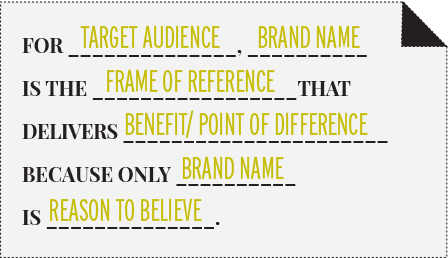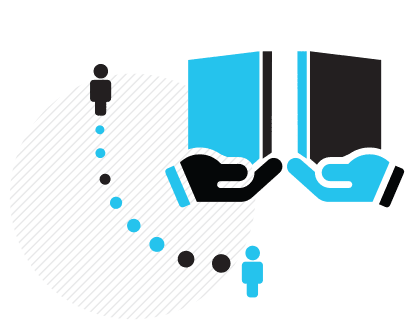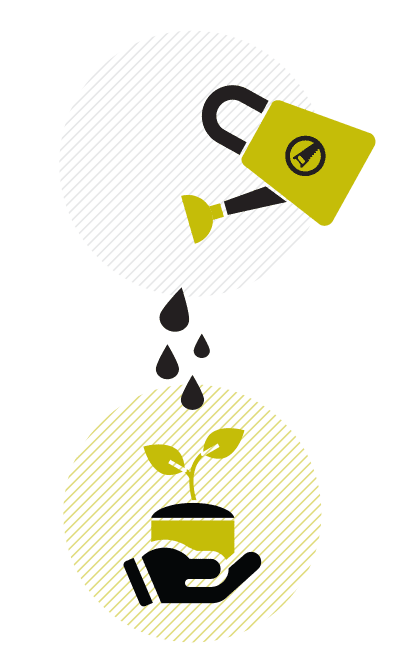A 12 Step B2B Brand Strategy Guide for 2023
For the latest on B2B brand strategy, please check out Drew’s new book, Renegade Marketing
Table of Contents
1. Clear Away the Clutter2. Brand Positioning - Dare to be Distinct3. Pounce on Your Purpose4. Internal Marketing - Welcome We5. Perfect Pithy6. Delight by Design7. Engage Employees First8. Cultivate Customer Champions9. B2B Content Marketing - Sell Through Service10. Measure What Matters11. Automate Attentively12. Marketing Experiments - Test to TriumphFrequently Asked Questions about B2B Brand StrategyIn Renegade’s 2020 survey among Chief Marketing Officers at 133 B2B brands, 85% agreed that B2B marketing had become more complicated in the last 12-24 months. And not surprisingly, the pandemic added to this complexity as 80% of these marketers had to find alternatives to physical events. But in a big swing from our 2019 survey, 86% of these CMOs believed their marketing had become more effective in the last 12 months. What changed and what can other B2B marketers learn from this as they navigate 2023?
Starting with the fact that 97% of the CMOs surveyed had to adjust their 2020 plans midstream and a full 50% had to rewrite their entire plans, you also have a whole lot of marketers having to do more with less (59% faced budget cuts). In these efforts, CMOs attributed their success to better overall marketing strategies (67%), better messaging (66%), a better understanding of their target (59%), and better marketing staff (55%). So, the first conclusion to draw is that removing budget forced a more streamlined approach, a conclusion we heartily embrace.
It is worth noting that our 2020 B2B CMO Survey also revealed that only 38% of the CMOs surveyed believe their marketing is substantially different from their competitors and only 41% can summarize their brand story in 8 or fewer words. We find this data shocking and hope you do too. Fixing this takes a whole lot more time than the 25 minutes you’ll need to read this report, assuming you don’t pause to ponder some of our provocative recommendations.
And this just in, Drew Neisser’s 2nd book, Renegade Marketing: 12 Steps to Building Unbeatable B2B Brands picks up where this report leaves off, adding dozens of case histories while adding in the CATS framework. Available in paperback, audiobook, and ebook, if you enjoy this report, you’ll absolutely love the book.
In this special report, we’ll detail 12 ways you can simplify your overall B2B marketing efforts in 2023, while also answering some of the common questions people ask about B2B brand strategy. In the spirit of keeping things simple, let’s start with the most basic question.
[This post has been edited as of February 27, 2023]
What is a B2B brand?
B2B stands for business-to-business and refers to organizations that market to other organizations rather than directly to consumers. ADP, for example, markets its payroll services to other businesses. KFC, on the other hand, markets its chicken directly to consumers. Both are well-established brands in that a vast majority of their target audiences are not only aware of what they do, but also, their audiences have some emotional feelings about the company. Some brands like Panasonic were once mainly B2C but are now almost entirely B2B. And there are a number of brands like Avid that market to both businesses and consumers. But for the purposes of this report, we’ll stay focused on companies that market exclusively to other companies.
These perceptions play a significant role in the purchase decision-making process of both B2B and B2C brands. The fundamental difference is that many B2B brands face a long sales cycle with multiple decision-makers involved since the transaction can end up being for millions of dollars.
As such, the perceptions of a B2B brand play a varying role during the purchase journey—but just ask any B2B salesperson, in general, which is easier, selling for an unknown brand or selling for a well-known brand? Being well-known can get you on the shortlist but it may or may not help you close the sale.
This is when we start to think more broadly about the notion of brand because every touchpoint, whether it is the landing page of your website, a demo of your software, an ROI calculator, a booth at a tradeshow or a sales presentation, has the opportunity to reinforce your brand OR muddle it. That’s why it is so important to have a crystal-clear brand strategy that informs everything the organization does—not just the marketing.
1. Clear Away the Clutter
Marketing has become way more complicated but not more effective. Be the Marie Kondo of marketing. Simplicity and focus are your new besties.
As 9 out of 10 B2B CMOs will tell you, marketing has gotten ridiculously complicated. For starters, modern marketers have built increasingly complex marketing technology (“MarTech”) stacks, that spew out data and chew up staff time. It’s not uncommon for the CMOs we interview to have more than two dozen such technologies costing more than a million dollars a year to maintain, and that doesn’t include the people needed to care and feed these beasts.

Even well-intentioned efforts to customize messaging by roles and personas can lead to an inconsistent view of your product or service.
And they are beasts. To operate at maximum efficiency, many of these systems need fresh “content” (the term modern marketers use to cover all types of communications from blog posts to videos, ads to white papers) every day if not every minute. In theory, the result is massive grids of stuff, produced at the lowest possible cost, that can be served up on any digitally-enabled channel, on a highly personalized basis. In practice, particularly for B2B marketers targeting enterprise customers, the theoretical promise rarely matches the executional reality.
Simplicity is very much in vogue these days. We are amply fed slick technologies that promise to “simplify” our lives, but we marketers seem to be going in the opposite direction. Perhaps we need to take a lesson from Japanese organizing guru Marie Kondo, known for The Life-Changing Magic of Tidying Up (in book, Netflix show and theory). Her passion is teaching others how to simplify their lives by purging their homes of unneeded and “joyless” possessions. We can and must do the same with B2B brand strategy.
Gartner’s Brent Adamson’s research foretells even longer sales cycles and more decision-makers, leading to a complex and convoluted buyer’s journey. Even well-intentioned efforts to customize messaging by roles and personas can lead to an inconsistent view of your product or service when the eleven-person-laden buying committee finally convenes, thus decreasing your chance of closing the deal by 2.2 times according to Adamson’s research. Regardless of the model, the buyer’s journey is creating new challenges for marketers, furthering the need for a crystal-clear approach to cutting through the clutter.
For many CMOs, clearing the clutter has to start with personal behavior; this means forming habits that will clear your own clutter, shaping the way for your team and the company’s culture do the same.
Kory Kogon preaches the need to pause and plan proactively. At the start of your week, take time—20 minutes, a full hour; whatever suits you—to simply think about the larger goals you have for the week. Plan out your week with specific steps to achieve these goals, and make sure that these broader goals don’t eat up more than 50% of a given day’s schedule. Kogon finds that this establishes a healthy balance of working towards your goals, while leaving flexible time to handle anything that pops up (or to simply collect yourself and reenergize).
Leaving room in your schedule is critical; as Kogon says, “In real life, you’re going to get interrupted.” Part of this is also thinking of each meeting and really interrogating whether or not it is needed—Kogon bemoans the “epidemic of meetings” that we often find ourselves in, and believes firmly that productivity and employee happiness will benefit from minimizing those meetings where you can.
The first step to building an effective B2B brand strategy is committing to clearing away the clutter. Forget all that you can do and, instead, focus on what you must do to make a difference. Undoubtedly, this takes courage. But fortune, as the old saying goes, favors the brave. Let’s make your To-Do list shorter and more meaningful. Let’s commit to simplicity not because its au currant but rather because its timelessly effective.
2. Brand Positioning - Dare to be Distinct
Conformity crushes marketers and marketing. Commodities aren’t us. Stand out. Better yet, be unique, inside and out.
Clutter cleared. Now what? Keeping to the basics, we need to focus on how you as a marketer can have a material impact on B2B brand strategy. Notice that we used the word “brand” and not “marketing” in front of strategy. That’s because you the marketer have an opportunity to transform your entire organization, not just the words and images that are used in your communications. Braced by their courage, this is what the most successful CMOs do.
The CMO role is well known for being the hot spot in the C-Suite, the one with the highest expectations, the shortest tenure and the most varied in terms of responsibilities. Essentially, you have an extremely short period of time to effect change, and that’s getting harder, not easier, given all of the spending options available to marketers. Thus, the need for courage.

In reality, most B2B brands are marginally different from their competitors and it becomes the marketer’s job to uncover something distinctive.
Specifically, you need the courage to fight for an over-arching brand strategy that differentiates your company. You need the courage to recognize that being unique, or at least distinctive, is more important than being better. Let’s chew on this a bit more – your top priority as head of marketing is to help your company stand out from the crowd. Period. If you can’t embrace this challenge, you’re probably in the wrong role. Anybody who wants to do effective marketing is probably going to have to take a chance and try something new.
A key part of daring to be distinct is recognizing that it’s not just enough to have a strategy; you need to understand the notion of uniqueness and what that means. It’s not that Ikea is better than Ethan Allen. They’re just different. Really different. Every aspect of the Ikea experience is unique. If you’re marketing Ikea, you’re starting with a brand that is fundamentally unique at its core. Lucky you. Most CMOs, especially those on B2B brands, arrive at companies that lack this caliber of uniqueness, having survived despite blending into their crowded markets.
In reality, most B2B brands are marginally different from their competitors and it becomes the marketer’s job to uncover something distinctive. The exercise many turn to is often called positioning, which is literally how a brand is different from its self-defined competitive set.
As a challenger brand jostling for market share with larger, established competitors, SentinelOne knew they had to get creative to stand out. CMO Daniel Bernard (DB for short) discussed how they did so in his recent interview.
A prime example was their approach to conferences. SentinelOne would set up their booth right next to the biggest competitor—a brand with a bird as their logo—and play a video facing the competitor’s booth, as the competitor had much more foot traffic. This video, cheekily titled “Flip the Bird,” ended up riling up the competitor to the point where they would actually discuss SentinelOne more than themselves.
Creative decisions that help brands stand out often don’t come from the playbook of tried-and-true tactics. SentinelOne realized they didn’t have the biggest stage, so figured out a way to get their name into the conversation by borrowing someone else’s. As DB says, “The challenger brand piece comes through in everything that we do. We want to connect with the prospect. We want them to know they made the right choice.”
With the challenger approach, SentinelOne has seen record high metrics over the last 12-14 quarters, winning against their competitors 7 out of 9 times and going public with great success in June 2021.
He goes on to condense his thoughts into a few key dos and don’ts:
First, have a competitor and know everything about them. If you don’t know what to differentiate yourself from, you won’t be able to form an effective strategy for standing out.
Second, take risks. DB shares: “Whether doing a TV commercial, a rebrand, hiring somebody from outside your industry… The only way you really crack it is when you take a risk that performs extremely well. Don’t do stupid things, but take big risks.”
Third, figure out the metric that your board wants to hear and that you need to follow. Follow the metrics, but don’t get caught flying your airplane looking down at the controls. For DB, that metric is the percent of wins every quarter won without a proof of concept.
As CMO Michael Welts of Wasabi and his CEO, David Friend, shared in their interview, they were both clearly aligned about the need for differentiation in creating a strong brand. Competing with traditional cloud storage companies, Wasabi communicated its distinctive value proposition (6x faster, ⅕ the price of AWS) with clever branding language “hot cloud storage” and a branded promise of three “peas:” a guarantee of price, performance, and protection.
Here is a generic positioning template that is used by B2C and B2B brand marketers:

Applying this approach to our company, Renegade, our positioning statement would be something like “for innovative CMOs of mid-sized B2B companies (target audience), Renegade is the only strategic boutique (frame of reference) that can guarantee your brand will cut through (benefit) because our ridiculously simple process really works (reason to believe). So far, so good. Except not. No employee will be able to remember that line let alone find inspiration from it. No customer will be able to parrot back that sentence when offering testimonials. And it’s even unlikely that a prospect will find such boastfulness compelling enough to investigate further.
Writing a positioning statement is a good warmup exercise, like calisthenics, but it’s not the end game for true B2B brand strategists. That comes when you land on a few words, preferably eight or less, that transform your positioning into something remarkable. In Renegade’s case, we just needed two: Cut Through. That’s it. It works internally, driving our process, shaping our internal conversations (cut the crap!) and how we think about our “product.” It works externally because it speaks to the ultimate benefit of working with us and sets an expectation that both our process and our product are efficient and effective. And it helps explains why our logo is a handsaw. It even inspires the premiums we send our clients. That’s a lot of communication for just two words. [See Step 5 for more on the power of pith.]
Narine Galstian, CMO at SADA, helped lead a successful rebrand built in part around the tagline “Together, We’re All In.” To get this distinctive new brand, Narine and her team rallied around the idea that they wanted customers to be customer for life. This meant offering them support at every stage of the process. The best way for them to set their support aside, they then found, was by involving customers into the process of creating helpful content. As Narine reports, giving customers places to “share their stories” really enabled SADA to live it’s new brand.
Ready to talk about your brand strategy?
3. Pounce on Your Purpose
Great brands like great leaders lead with purpose. Find yours. Commit to it. Make it real. Keep it real.
Over a decade later, Simon Sinek is still in the moment. His 2009 book Start with Why is the standard-bearer for the purpose-driven movement, which beckons brands to find their unique reason for being. EY has added “purpose” not only to their own brand strategy but also as a distinct consulting practice, helping other organizations to follow their lead. Many other consulting firms and brand strategy agencies have done the same. There are many enlightened (and at least one practical) reasons for taking this approach.
On the enlightened side, consider that 63% of consumers globally prefer to buy goods and services from companies that stand for a shared purpose that reflects their personal values and beliefs, and are ditching those that don’t, according to new research from Accenture. The 14th annual Accenture Strategy Global Consumer Pulse Research– “From Me to We: The Rise of the Purpose-led Brand”—surveyed nearly 30,000 consumers from around the world to gauge their expectations of brands and companies today. The study found that companies that stand for something bigger than what they sell, that communicate their purpose and demonstrate commitment, are more likely to attract consumers and influence purchasing decisions, which improves competitiveness.

Companies that stand for something bigger than what they sell…are more likely to attract consumers and influence purchasing decisions.
In our revealing podcast interview, Bank of the West’s Chief Marketing and Communications Officer, Ben Stuart, explains his purpose-driven brand. “Society is changing. Entrepreneurship is changing. The face of youth is changing. The face of leadership is changing. Energy is changing. The environment is changing. And you need a bank to keep up with the pace of change for a planet that in a constant state of change. That’s why we’re ‘the bank for a changing world.’”
Recognizing the change is one thing, actually embracing the change is yet another, especially when it means changing how and with whom you do business. Stuart continues, “Most of the language of banking is bankrupt, including the subject of sustainability. We need to talk about specifics, like our investments in the community, diversity and renewable energy. Real things, real commitment. So, Bank of the West spent energy talking about what sets them apart; they will not finance tobacco, coal-fire power plants, fracking wells, or certain types of palm oil if it’s not harvested correctly, which is fundamentally different from the competition.”
This approach had sharp teeth initially, as Bank of the West needed to put its money where its mouth was and actually divest upwards of a billion dollars in assets that had been going to areas misaligned with the brand’s purpose. On the flip side, Bank of the West has enjoyed significant growth in other business areas, particularly in its two biggest states, California and Colorado. As noted earlier, it takes courage to identify and stick to a distinctive brand strategy, particularly one that is purpose-driven. (Click to hear the podcast interview with Ben Stuart.)
Pouncing on your purpose has a couple of important practical benefits. First, many B2B companies, even category leaders, find it hard to keep their products, services or processes distinctive. Competitors flock to success like fleas to a dog. They study and try to copy what you do and how you do it. But what they can’t do is copy your “why,” especially when it becomes engrained in every aspect of the organization. When that happens, watch out. Employees are more engaged and customers are more loyal. And prospects notice.
Julia Goebel of symplr/Halo Health notes that they began looking for “Connect to Purpose” moments—where they would examine their work and look for the moments where they could see if they were following their guiding vision of putting devices in the hands of clinicians to help them save lives. It’s noteworthy here that Julia’s team consistently evaluated—and evaluates—where the brand purpose comes in. As shes says in her recent interview, “We’re not only standing up for a purpose that’s believable and executable, but also ensuring that it is durable. That it’s not just a campaign this year, it’s something much larger than that.”
Peter Neiman, CMO at Amalgamated Bank, has helped the bank commit to ethical investments that align with a core purpose of being “America’s socially responsible bank.” As he puts it, “purpose isn’t going to be optional down the road. It’s the way brands are going to differentiate themselves now, especially those that don’t have a highly differentiated product.” The bank has it’s roots in helping poor immigrants protect what money they had—and they’ve aimed to stick to those roots of supporting the interests of the working class, and broadened it to helping make the world a better place for everyone.
What’s more, purpose is agile; it’s the steadfast guiding light when pivoting under the pressure of unforeseen challenges. In a recent podcast interview, Reltio CMO Jakki Geiger shared how the company’s purpose played a key role when they repositioned their messaging in just three days this March. Pivoting from a message of “winning” to “serving, protecting, and retaining,” Reltio stayed true to its mission—to empower the experiences of the future with data that mattered to customers.
These are the three questions Jakki recommends taking a hard look at these three things when looking for solutions to difficult business decisions: “Why are you here as a company, what purpose do you serve as a company, and how do you take the message you’ve got and tweak it so that it’s more in tune with the current situation?
4. Internal Marketing - Welcome We
Marketing is best played as a team sport. Involve your organization top to bottom early and often. Share the credit and the gear.
John Costello, the former CEO and CMO of Dunkin Brands, shared a maxim to a large gathering of CMOs that I’ll never forget. Quoting Harry Truman among others, Costello said, “Anything is possible if you don’t care who gets credit.” This is great counsel for any person in any situation but is particularly important to B2B marketers. In truth, we marketers can’t drive meaningful organizational change on our own. We need a lot of help from a lot of other departments.

In your effort to welcome we, be sure to include the following action items:
- Befriend your HR leader: Work with them to “engage employees first” (see Step 7). Field an employee survey upfront to benchmark attitudes about the company and to gather feedback on the brand itself. The survey itself sends a signal to employees that you care about “we.”
- Befriend your CFO: Work with them to help “measure what matters” (see Step 10). Teach them about the inclusive power of marketing, that we can’t just measure leads and revenue. Have them teach you about the financial mechanics of the organization. Every marketer needs to understand how their company actually makes money.
- Befriend your Head of Sales: Start by going on a sales call as an observer but then do a sales presentation on your own. Your Sales Chief will appreciate your effort to walk in their shoes. From there, you can start to break down any Sales versus Marketing tension. B2B marketing is hard enough without this unnecessary yet age-old conflict.
Dara Royer’s journey as Chief Development and Marketing Officer of Mercy Corps is profoundly instructive for all businesses, especially those with modest budgets and massive expectations. Mercy Corps’ rebranding increased awareness, revenue via donations and recognition by the Harris Poll as the 2017 EquiTrend “Brand of the Year” and “Most Loved Brand” in the category of International Aid Nonprofits. Those are results that would delight any chief marketer. But how the heck did Royer and her team accomplish so much with so little?
Ultimately, key takeaways from Dara’s rebranding efforts can be seen as a mini-marketing plan spelling out frugality, storytelling and leadership. For starters, Royer took the idea of “DIY,” or do it yourself, to a whole new level in her rebranding efforts. Wanting to develop a solid strategic foundation for rebranding, Royer knew that conducting research would be invaluable. The only problem was cost. Typically, a global study involving hundreds of interviews can cost more than a hundred thousand dollars, money her organization did not have.

Every marketer needs to understand how their company actually makes money.
So, what did Royer do? She made sure her team was trained in research methodology and equipped them with the communication skills to work with their team members, government officials, and the beneficiaries of the people they help. By dedicating that time and energy to training her team, they were able to produce consistent and valid results that allowed specific themes to emerge and guide their rebranding efforts. Involving the organization in the research had the added advantage of making all the key stakeholders feel like owners of both the process and the ultimate outcome.
Royer found that the toughest lesson she had to learn when it comes to rebranding is that being right early on doesn’t matter. Even if you think you have the big idea, you can’t just expect a large organization to fall in line. Consensus building is an art form that no enlightened leader can succeed without mastering. Fortunately for Royer, the necessity of conducting the research in-house had the added benefit of involving a large number of employees in the process, making the ultimate adoption of the new brand positioning less of a sales effort and more of a “look what you all helped create” success story. [For our complete interview with Royer, click here.]
Suzanne Kounkel, CMO of Deloitte, has helped champion a brand that encourages employee participation wherever it can. She notes the importance of opening up an infrastructure for employee participation, leaning heavily into examining the variety of voices available, and doing so across all channels of communication. As she says, “You have to talk to your employees about why you’re doing things, versus what you’re doing.” She goes further, noting that “employees can be a really important focus group for your external messaging; if they don’t get it or it doesn’t resonate, it’s probably not going to work externally.”
“Welcoming We” can’t just be theoretical—as demonstrated by the aforementioned array of marketers, it requires setting up channels for communication and really tapping into the broad range of voices available at the company, and among the customers.
5. Perfect Pithy
Find your 8-word story first. Then touch souls with your distinct voice. Edit everything. Get to sparse before sprucing up copy.
The keystone component of Renegade’s B2B brand strategy process is the need to perfect pithy embodied by what we call the “purpose-driven story statement.” These profoundly powerful phrases of 8 words or less are far more than a clever tagline. Done artfully, these carefully crafted words represent an organizational promise, a purposeful commitment to all stakeholders.
Take Command Alkon’s “Together we build amazing,” for example. As discussed in CMO Ed Rusch’s podcast episode, those 4 simple words tied the brand’s entire transformation together. The “together we” reinforces the brand’s collaborative spirit whether that be between employees, customers, or the heavy construction community at large, “build” nods directly to the product itself, and “amazing” refers to the brand’s aspirational goal as it transforms construction technology for the better.
Purpose-driven story statements are the guiding light for employee engagement programs, customer retention initiatives and new customer acquisition endeavors. And, as evidenced in 2020, these statements are also the contingency plan you didn’t know you needed when faced with unexpected business disruptions.
These statements serve as guiding lights for your brands, and should aim to succinctly speak to customers, employees, partners, and anyone who looks at the brand and wonders what it’s about. Here, Kipp Bodnar of HubSpot preaches clarity and recommends considering your target heavily: “To get out of that sea of sameness, you have to be clear on what you are not for and who you are not for. You have to be okay being for some group of people and not for another group of people.”
Altair’s pithy “Only Forward” was the rallying the brand needed when this year’s events changed everything. As CMO Amy Messano explained in her interview: “For us, that’s the reaffirmation of our mission, which is helping people accelerate the pace of innovation and driving human progress. That really struck a chord in this particular juncture of time.”
To further illustrate the difference between a tagline and a purpose-driven story statement, here is one more example of a pithy phrase that could, with a few more actions, blossom into a fully integrated B2B marketing program.
Most likely you’re one of the many millions who have either completed a survey or fielded one on Survey Monkey’s seemingly ubiquitous platform. Awareness is not their issue, noted CMO Leela Srinivasan in our interview last year. Since joining the company in April 2018, her goal has been to inspire usage overall and increase adoption of their enterprise-level services. Getting there meant making their Power the Curious tagline real on multiple levels.
To do this, Srinivasan first focused on her internal audience, encouraging employees to create their own surveys, as well as surveying employees for feedback on how to make the company stronger. She also orchestrated a “Curiosity Conference”, bringing users together to talk about the vital importance of curiosity, not just to marketers but to society as a whole. In our podcast conversation, we discussed more ways to make “power the curious” real, like conducting an annual study on curiosity itself, especially since incuriosity seems to be on the rise (at least in certain political corners).

Purpose-driven story statements are the guiding light for employee engagement programs, customer retention initiatives and new customer acquisition endeavors.
In the interest of helping you perfect a pithy B2B brand strategy, here’s a brief summary of how Renegade gets there:
- Discovery: We do a deep dive into the organization via interviews with employees, customers and industry experts. This is also when we conduct our employee engagement research. At the end of this, we create a SWOT (strengths, weaknesses, opportunities, threats) document boiling all the information gathered down to a few core insights.
- Strategic Summary: Here we define in the simplest terms “what” your brand does, “how” your brand does it, and “why” you do it. At the same time, we’ll go through the positioning exercise (see Step 2) and identify your brand archetype (see Step 6). Sometimes, we’ll create a Venn diagram that looks at the brand, the category and the target’s needs, to see if there is a central notion that’s ownable. The goal is to have the key elements of the brand strategy on one page, all of which supports the purpose-driven story statement.
- Simplifying exercise: Here we ask what can we get rid of? For example, many B2B software companies create multiple sub-brands that they try to market individually. Often these names add little value to the sales or marketing process and the primary company could benefit from offering one platform under one name with multiple modules. These modules can have clear descriptors but don’t typically need their own brand name. Additionally, these modules can sometimes be combined to create a more compelling and more distinctive product/service.
- Purpose-driven story statement: This is where the pixie dust of what we do at Renegade comes in. It does take some creativity to put just the right words together in the right order. You will know you have a strong story statement when the language is inspiring, dramatic, distinctive, and functional (like explaining what category you’re in) yet emotional. AND it must be available. Always use the free TESS search tool offered by the US Trademark Office to see if anyone has used this same language. As a further precaution, do a Google search of the line both with and without quote marks.
It doesn’t hurt to have a long track record as a writer of these statements, so don’t despair if your first couple of efforts produce language that’s been used before. It can take time, maybe even a career, to perfect pithy.
6. Delight by Design
Aesthetics send signals. Kludgy design anywhere prevents brand love everywhere. Bake design into your organization.
Great brands, whether B2B or B2C, have a distinctive look, feel and voice that you can recognize instantly. Think about Apple, Nike and McDonalds. What comes to mind first? Probably their logos and then a particular aspect of their brand experience. Apple stores with their glass, wood and t-shirted geniuses. The Nike swoosh and exerting athletes. The McDonalds arch, red french-fry holders and clean bathrooms.
Now try to do this exercise for B2B brands. IBM is certainly top of mind with their slotted logo and the blue frames of their TV ads. But what else comes to mind? Beyond Watson, it’s a bit of a blur which is understandable given the size and complexity of their business. If you’re a small or medium-sized business, you actually have an advantage. You can bake design into every aspect of your business, helping you to stand out rather easily from your kludgy competitors.

Great brands, whether B2B or B2C, have a distinctive look, feel and voice that you can recognize instantly.
What is B2B brand design?
B2B brand design on its simplest level is the visual appearance of your brand including logo, fonts, colors and images. The more consistently these elements are used together the more embedded they become in the minds of your target audiences. Done correctly, B2B brand design tells a story about your brand. Like a great picture, great design is worth a thousand, if not a million, words.
Let’s start with color. To illustrate the power of color let’s look at the rental car industry. Which brand is Gold? Red? Green? Easy, right? Okay now tell me what color is Budget, Dollar and Alamo? That gets a lot harder. The consistent use of color can have a material impact on the way people think about your company. Gold is top notch, classy. Red is strong, determined and passionate. Green is associated with growth, safety and money. This is an overly simplistic interpretation of the meaning of colors, but you can see how in the world of rental car companies, color choices do have an impact on brand perceptions.
Here’s a very easy exercise to see if your brand is using color to its advantage. Look at all the logos and visual design schemes of your competitive set. If you’re creating a new category, then look at brands that are marketing to your same target audience. Evaluate each of the competitor’s brand design just in terms of color. Is there one color or a combination of colors that they use consistently? Does this color convey something about the brand that distinguishes it from a sea of sameness?
How to use color for B2B branding
ReceiptBank is a great example of a niche brand that uses color to help itself stand out. Targeting the typically staid world of accountants and bookkeepers, ReceiptBank offers a receipt capture app and management system that takes the drudgery out of this normally tedious task. Since the product plugs into major accounting software products like Quickbooks and Xero, ReceiptBank often exhibits at software conferences, ready to help bring attendees into the mobile future.
Dressed in bright orange t-shirts that match the orange in the brand’s logo and signage, the army of ReceiptBank employees send a clear and distinctive message – we’re here, we’re friendly and we’re ready to help. ReceiptBank enjoys the highest conversion rate of visitors at tradeshows of any of the over 300 brands I’ve personally interviewed. It helps that they always have a strong and compelling offer. But being the only orange brand in their industry also makes a big difference.
When ProsperWorks decided to rebrand, they changed their name to Copper and made the audacious choice of the color pink for all their branding. For a software company targeting other businesses, this was a bold move. It also reflected a dramatic transformation of the product, which they redesigned from the ground up. How better to signal a major change than through the use of an unexpected color? You can listen to our extensive interview with Morgan Norman, the CMO of Copper, here.
In many cases, it may be up to the CMO to show employees, customers, and stakeholders why an aspect of design needs to be changed. CMO Carla Piñeyro Sublett of NI shared that it took about 45 days to reach an agreement to change the brand’s colors from a traditional blue to a vibrant green. Once everyone in the organization understood the why, NI launched its newly designed, purpose-packed, modernized brand with great success and full employee support.

Don’t try to communicate everything, but do try to include at least one thing that is clearly yours.
Color is but one aspect of brand design. As mentioned earlier, type, visuals and even language can have a huge impact on B2B brand design. One way to assess your organization’s appreciation for brand design is to find out when the first in-house designer was hired. If that hire happened really early on, no doubt you’ll see design permeate the organization, not just from an identity standpoint but also from a user experience perspective. You may not always notice good or great design but you will certainly notice it when it’s not there. Think about a recent website visit. Did you find what you were looking for in a matter of seconds? Did the landing page calm you or make you anxious? Was the design consistent? Great designers solve problems. Bad design creates them.
There are many more elements to brand design including logo, brand voice and visualization which we can’t do justice to in this report. As such, let’s end this section with two quick thoughts:
B2B Logo Design:
Less is almost always more. Don’t try to communicate everything, but do try to include at least one thing that is clearly yours. Often the logo mark or bug can do this. Accenture has its arrow tip. Cisco its bridge-forming bars. Make sure the font you use for your brand name is readable from a distance and works in extremely small sizes like on mobile device. Intel is a great example of a highly legible brand name with one unique element – its backwards e.
B2B Brand Voice:
In the interest of clarity and simplicity, consider aligning with one of 12 Jungian archetypes. These archetypes like “Joker” (think Geico, Bud Light) and “Explorer” (think Jeep, Patagonia), have rich backstories that can help inform and distinguish all of your brand content. Here’s a link to a website that can help you assess the archetype with which your brand currently best aligns. Importantly, if most of your competitors have adopted one particular archetype like “Sage,” you’ll want to explore other options.
Overall, your brand needs to follow a few simple tenets: be distinct, support your overall mission/purpose, and make it easy for the customer to understand.
Dan Gingiss, Founder & CEO of The Experience Maker, shared some thoughts in his recent interview: “Almost everybody’s experience is ordinary. All we have to do is be a little bit better than almost everyone else, and we’re going to stand out.” This mindset is extremely valuable, and can be an excellent guiding thought in forming your brand. Consider your internal objectives, form a brand with customers in mind, and ask: ”Are we standing out? Are we delivering something that is better than ordinary?”
7. Engage Employees First
If employees don’t believe, no one will. They are the front line that drives the bottom line. When they’re inspired, goodness follows.
In Step 4, we discussed the importance of involving your whole organization in the strategic development process. As part of this, we recommended fielding an employee survey at the start of your B2B branding or rebranding journey. Not only will this research provide useful benchmarks to track against after your new branding is in the marketplace, but it will also yield valuable insights that can drive your efforts.
In an employee survey that we fielded in 2019 for one of our clients, we uncovered a couple of lingering issues from a previous rebranding effort. As such, when we developed the new plan, we were able to include specific components that addressed past issues and assured that the new program would be well received. Here’s the key – if employees don’t believe in the brand, if they can’t embody the spirit of the brand, then there is little hope that your marketing activities will actually make a difference. This is why for every B2B marketing or rebranding program we recommend that employee communications happen in advance of any external activities.

If employees don’t believe in the brand…then there is little hope that your marketing activities will actually make a difference.
The importance of internal communications is not a debate. In our proprietary research study among B2B CMOs, over 80% acknowledged the critical importance of employee communications. But, and there’s a great big but here, only 10% of CMOs allowed for more than one month of internal comms before launching externally. This inconsistency is significant. Basically, these CMOs are saying, our new marketing initiative does not require any substantive organizational changes or meaningful educational efforts. What’s wrong with this picture? A lot.
B2B brand strategy needs to be about more than logos, words and pictures. Effective B2B brand strategy is about making a distinctive promise to the marketplace and then delivering on that promise in as many ways as possible, as consistently as possible. At the center of this promise are your employees. They make the promise real. And if you’re making a new promise, there’s a pretty good chance you’re going to need to make some changes to how you do business, how you interact with your customers and how you recruit new employees. All of these things need to be aligned. Here’s a story of how that happens.
David Edelman joined Aetna in 2016 as CMO. That year, the healthcare industry was ranked just above the pharmaceutical industry and the federal government as Americans’ three least favorite business sectors. These negative feelings run deep and create a formidable challenge for healthcare marketers, especially since messaging alone is unlikely to change perceptions. So, how does a chief marketing officer approach, let alone solve, a gargantuan problem like this?
First you do your discovery homework. Then you find your purpose-driven story statement which for Aetna is “You don’t join us. We join you.” Then, notes Edelman, “We took that tagline, and we started to flesh out the implications of it. We created six design principles that would guide anything new that we brought to market. One of them is ‘know me.’ When somebody calls in, we must know everything they would expect us to know about them. We took that on the road and really helped people on the frontline understand what that meant for them in terms of their interactions for customers.”
Edelman continues, “We then engaged all the top 250 leaders of the company in the same way and had them cascade that down. It led to not just people understanding it and feeling a sense personally of what it means, but also some priority initiatives of tangible changes. That whole process took about six months. We’ve seen greater employee engagement since then, and that emotional tie has been really powerful for people. This sense of mission is a powerful magnet for people who want to engage in helping to change healthcare.”
Aetna spent six months retraining employees to make sure that their new brand promise could actually come to life. This is what it really means to engage employees first.

Effective B2B brand strategy is about making a distinctive promise to the marketplace and then delivering on that promise in as many ways as possible.
CMO Norman Guadagno joined Acoustic, an IBM spinoff, as the first-ever CMO on the same day as the 1,000-employee startup brought on its new CHRO. Knowing how crucial it was to build a culture, Norman partnered with his head of HR. As he explained in his interview, they both believed that companies’ cultures brands are born with people and they established an employee ambassador program founded on the idea that “Building a brand starts on day one with an employee.”
There are myriad ways of engaging employees. Here are a few examples that our clients have adapted to align with their new brand stories:
- Start an employee book club in which everyone reads the same book each month.
- Develop a proprietary training program that reinforces your new brand promise.
- Revise the employee evaluation form to emphasize the updated brand promise.
- Develop an awards program that brings the new promise to life.
- Establish a reverse mentoring program such that execs are teaching leadership skills to entry level employees who in turn share their social media know-how.
- Create a mobile app that enables employees to recognize other employees.
- Deploy an employee social media ambassador program.
- Train employees on how to build their personal brands in alignment with the company brand.
- Create special days or weeks for coming up with new ideas.
In sum, engaging employees is not an optional luxury. It’s a necessity for effective B2B branding.
Suzanne Kounkel, Deloitte’s CMO, has formed a handy set of dos and don’ts to keep in mind when trying to get engage employees:
- Do find ways for employees to participate, direct, and shape what the internal communication looks like, whether it’s topics or channels.
- Do lean into the variety of voices you have in the executive suite. People listen more to the people that are directing their performance, their day-to-day lives, etc. Funnel all of the other speakers through those voices.
- Don’t think any one channel is sufficient. Engaging employees properly requires effort across each available medium of communication.
Of course, finding employees worth engaging is just as crucial when building a brand, so it’s high time for CMOs to upgrade hiring practices for 2023. Be sure to check out this episode with Aptology’s CMO Caroline Tien-Spalding, where she shares insights for building effective teams and organizations. One of her key recommendations: start with helping your team understand themselves.
8. Cultivate Customer Champions
Do what it takes to engender brand love. Make them the heroes of your story. Inspire them to share the wonders of your product/service.
It seems obvious enough. Every B2B brand is in the business of acquiring new customers while keeping current ones for as long as possible. And typically, the business priorities are written in exactly that order. In this report, we switch the order, arguing that cultivating customer champions needs to be the top organization priority especially when embarking on a rebranding effort. Wait, what?
Let’s step back for a second. You’re the CMO. You’ve gone through a B2B rebranding process. You’ve found your unique positioning informed by purpose and cleverly expressed it in eight words or less. You’ve introduced the idea to employees and even retrained them to deliver upon the new promise. So far, so good. Now, why not just take this directly to your prospects and see the new revenue begin to flow? Simple. If your customers can’t see their way to embracing your new brand story, chances are it will die before its time, never turning into the prospect-attracting nectar you so covet.
There are several reasons for this. First, almost no B2B transactions occur without a reference check in one form or another. In fact, few of us even take a meeting without first Googling that individual and the company for which they work. Inevitably, we find ourselves looking at online reviews and making snap decisions. Who wants to waste timing meeting with a company with a poor reputation?

If your customers can’t see their way to embracing your new brand story, chances are it will die before its time.
A second reason is that few prospective customers are daring enough to “eat the first oyster” so to speak. Much to the frustration of many sales reps, one of the first questions a potential B2B customer will ask is, “Have you worked with a company like mine?” They are simply seeking reassurances that your product or service will work for them, that you understand the challenges specific to their industry and have already solved for them. It’s not an unreasonable question even if it does demonstrate a certain lack of imagination.
The third and most important reason to cultivate customers first when embarking on a B2B rebranding program is that you really need customer buy-in. Assuming your new branding is not just a fresh coat of paint on an old barn, but one that encompasses meaningful changes to your customer experience, if not the product itself, then you’ll definitely want your customers on-board from the earliest possible stages. Ideally, your top customers are actually brought in during the development phase to help inform if not validate your new direction.
Before they can be champions, they must be satisfied.
Let’s start with the basics. Your product or service comes with a fundamental promise in terms of performance. Expectations are set during the sales and purchase process. At minimum, these expectations must be met. Duh, right? But before breezing by this business 101 observation, are you absolutely sure your product or service is meeting expectations? One way to know is to read online reviews. Another is to talk to your customers regularly about your performance. A third is measure customer satisfaction (c-sat) at regular intervals, the most common measure today being Net Promoter Score (NPS).
Fred Reichheld’s seminal book, The Ultimate Question, launched an entire industry around a single question to measure c-sat. Though some of Reichheld’s early data has subsequently been disputed, NPS remains a stalwart of measuring customer satisfaction, via an easy question to ask: on a scale of 0-10, 0 being the lowest and 10 being the highest, how likely are you to recommend XYZ product/service to a friend or associate? While we’ll explore alternative measures in Step 10, the point here is that you recognize the need to meet if not exceed customer expectations and are committed to some form of measuring this.
How can you cultivate B2B customers?
Beyond the basics, there are myriad ways of cultivating customers. Of course, some of the options depend on your category or industry and the standards that have been set. If, for example, everyone in your software segments offers 24/7 live customer support, then not offering it may distinguish your brand in a bad way. There may also be basic functionality that needs to be factored in.
We were doing some customer interviews for one of our clients when we learned that c-sat was higher for customers who had purchased the analytics module on top of the basic product. This analytics module enabled customers to see the impact of the software and thus made them feel better about the overall return on investment. Maybe you have a similarly tiered offering. It is at this point you should ask yourself, are we charging our customers extra for something that impacts their likelihood of recommending our brand? If so, maybe it’s time to bake that into your product, even if it means charging more.
A number of B2B brands have some form of customer advisory board. These are typically the largest and most engaged customers, the ones who consistently serve as references and feel a proprietary relationship with the brand. They see themselves more as partners and are willing to give their time to look at the product roadmap or pilot test new iterations. It’s easy to rationalize giving these folks a special level of treatment – they are in fact the crown jewel. So the next question is, can you extend this treatment to a broader level of customers?

Ask yourself, are we charging our customers extra for something that impacts their likelihood of recommending our brand?
While we’re contemplating the idea of extending your best treatment to a wide swath of customers, let’s quickly touch upon customer events, small and large. On the smaller side, these are hosted gatherings of your customers for a meal or an extended meeting. These events can serve your customers on different levels and need not be just about your product or service. Ideally these events bring your new brand purpose to life in a memorable and distinctive fashion such that when your customers leave, they’re ready to evangelize on your behalf.
Let’s start with the small. Gaurav Chand, CMO and EVP of Cognizant, an information technology company, discussed his brand’s F1 sponsorship in a recent interview. They partnered with Aston Martin in part because Aston Martin, much like Cognizant, was a relatively new player in the field, looking to make a name for themselves in the luxury car space. Plus, Cognizant saw an opportunity for their product to help this F1 team compete better.
Finding the right target—one that aligns with the brand in as many ways as possibile—is a great start. While this sponsorship marked a massive step, Gaurav notes the importance of the small things here, like ”something as banal and simple as a client invite.”
In planning events around F1—watch parties, that sort of thing—Gaurav looked for small moments to stand out and impress clients. Instead of sending an event or viewing invitate via an email from an employee, Cognizant sent a video invite from one of the F1 drivers to the client, marking a large upgrade to an often overlooked portion of the event process.
However, that small moment turns into am unforgettable one and a big win. Most companies probably wouldn’t sweat the small stuff to that extent, but doing so truly helped Cognizant stick out in the minds of their clients.
Similarly, Cognizant sponsored the PGA tour, where a client was excited to see their favorite golfer Brooke Henderson. Cognizant’s team worked with the PGA staff to see if Brooke would do something as simple as take a picture with the client, and it paid off. The client got a quick picture, texted their mom about it, and bam—that’s an incredible amount of goodwill cultivated.
In a bigger scope, Dreamforce, Salesforce’s annual user conference, is the largest representation of using events to build customer loyalty and inspire word of mouth. With over 171,000 reported attendees in 2019, Dreamforce has become a multi-billion-dollar ecosystem unto itself. But your events need not be this big. In my 2017 podcast interview with Elissa Fink, then CMO of Tableau, she talked about starting small with only 100 attendees at their first user conference. This number reached into the thousands after a few years, reflecting both the growth of the brand and the passionate nature of their user base.
Now that 2020’s digital transformation and work from home mandates have changed events as we knew them, B2B brands have had to learn the best way to convert a physical event into a virtual one. While many brands missed the mark in the initial scramble to host a memorable, high-quality event online, CMO Michelle Boockoff-Bajdek and her team at Skillsoft created a global experience that rivals pre-COVID physical events.
With 41,000 registrants and a 34% attendance turnout, Skillsoft’s Perspectives 2020 was a huge success. As Michelle shares in her interview, they also experimented with an entirely new model for customer presentations to ensure high engagement levels: “We looked at that HBR-style case study where we had a written case study for our customers and then a 10 to 12-minute TED-style talk with the presenter and a Q&A.” The response was so compelling that Skillsoft plans on testing the same model when in-person events return.
How does a cultivated customer champion behave?
Ultimately, a cultivated customer champion expresses brand love in all sorts of important ways:
- They continue to buy your product/service;
- They are keenly interested in your development roadmap;
- They show up at your user conferences;
- They evangelize about your brand to their peers offline and via social media channels;
- They allow your company to use their brand name on your website and in sales materials;
- They participate in case histories;
- They provide testimonials and are willing references.
The last three areas are a challenge for new brands and companies in sensitive markets like cybersecurity. For new brands, it’s sometimes harder to get testimonials because there is a reluctance among the sales or service people to ask for them. Seems silly, right? Nonetheless, not asking is the surest way not to have enough case histories and references!
There are times when, for strategic reasons, your customers might not want to provide testimony. Occasionally, they’ll see a particular supplier as a source of competitive advantage and simply don’t want others to know. Or they see your security product as so important that they wouldn’t want the bad guys to know you’re using it. In theory, this should feel flattering. But most of the time, it’s just making your life more difficult. Here you need to make the case that both organizations win when yours grows, since growth usually helps drive product improvements. And your growth is dependent on having top quality case histories and references. This argument doesn’t always work but it’s worthy of conversation.
Here are a few ways to generate B2B customer case studies and testimonials beyond what we’ve discussed above:
- Build testimonial rights and incentives into your contracts. We’ve worked with some brands who offer up to a 10% discount to any customer who agrees to be featured as a customer on promotional materials. Even without an offer, the best time to ask is upfront so it doesn’t come as a surprise later on in the relationship.
- Develop a highly visible and creatively executed case history program. If the quality (video and/or written) and visibility (promote via ads and at events) is strong enough, customers are far more likely to want to participate and will see it as a way to promote their own brand.
- Establish a customer-only awards program. Just about everyone appreciates recognition and will find an awards program hard to resist. These awards can reinforce your overall brand promise and through the application process can help gather the facts you need to produce great case histories.
- One of the biggest benefits of cultivating customer champions is that it will make your job a lot easier. Yana Nigen, CMO of JobDiva, puts it this way, “Marketing became simple in the past 12-24 months as our highest source of lead traffic comes from client referrals.”
Hopefully, you can see why cultivating customer champions is an essential step to success in B2B brand strategy development.
9. B2B Content Marketing - Sell Through Service
Be a giver. Give away your insights, your tools, your product, your service and your swag. Make it easy to buy.
In 2010, American Express wanted to help its small business customers find a way to compete in the middle of Black Friday and Cyber Monday, so they created Small Business Saturday. John Hayes, who was CMO at American Express when Small Business Saturday launched, noted in our interview, “We don’t do things just because they’re a trend, we do things because it’s the right thing to do for our customers.” In 2019, Small Business Saturday generated a record $19.6 billion in spending. That’s a lot of sales which is why in this report we call this approach “selling through service.”
One of the better-known advocates of this idea is Brent Adamson. Adamson is a principal executive advisor at Gartner and author of two must-read bestsellers, The Challenger Sale and The Challenger Customer. The second book is most relevant to this report because, in it, Adamson points to a fundamental problem in B2B: “buying is broken” and the only way to solve the problem is to “make buying easier” through a series of actions.
Adamson’s central theme for B2B marketers is not that you have a problem selling. It’s that customers have a problem buying. The buying committee doesn’t form right away. You get a champion or mobilizer who comes in, claiming the need for a new software solution that will save time, money, resources or some combination of the three. They form a committee with a senior person from IT, security, and procurement. They go around and do their homework, researching vendors. Then the CEO asks to be a part of the initiative. So they start again. New people get involved. Then your champion says in the ninth month, “We just found out that our finance review committee needs to assess deals over $1 million, and, sorry but they don’t meet for two months.”

Anticipate the needs of the individuals on the buying committee and to do things that support the process.
Eighteen months later, even if you close the sale, the process was so arduous that many times your new customer isn’t even happy with their decision. The solution is to anticipate the needs of the individuals on the buying committee and to do things that support the process. “Make buying easier,” prescribes Adamson, as you can hear in our multiple interviews (2018 part 1, 2018 part 2, 2019, 2020). Create the tools and content that will make buying your product or service a bit less torturous if not an outright “no brainer.”
Which leads us back to Selling through Service. To get started, you need an intimate understanding of your customers, their rational needs, and their emotional state of mind. It continues with the mindset that your marketing can provide a genuine service to your customers. It can educate. It can inform. It can inspire. It can resolve a debate. It can enhance careers. It can provide a laugh on a gloomy day. It can sell without selling.
In 2020, Pluralsight recognized a unique opportunity Sell through Service in service to the brand’s mission: to democratize tech skills across the world. Its altruism materialized an offering known as #FreeApril, giving away a full month of access to all of the platform’s online courses for free.
Not only did this garner 1.1 million users and a serious boost in brand awareness—but it also helped Pluralsight far exceed revenue goals set before all of the challenges of 2020 came to light. As CMO Heather Zynczak shared in her interview, “This has been a great lead generation tool for us on the B2B side. It was also 15,000 new logos—15,000 logos that we don’t have a B2B contract with. Of those 200,000 contacts, there were 15,000 new accounts, which is huge for us in terms of customer base.”
To sell through service, you’ll need to first map out your customer journey and all of the individuals who will have some impact on the ultimate buying decision. If, for example, you know all of your buyers are going to do a category assessment, complete with feature comparisons, then you would be wise to preempt this with one of your own. Here you have an opportunity to save your prospect lots of time and when done correctly, help them make the right decision for their organization.
This is not as altruistic as it sounds. Remember Step 1, clear away the clutter? Part of that exercise is the realization that not every prospect will be right for your organization. If your content helps sort out the “roses” from the thorns, then you’ve just saved your organization thousands of prickly man-hours. Keep in mind, leads are not the end goal of B2B marketing. The end goal is to make it easier for the right customers to buy your product or service.
In March 2020, the global software brand Centro did just that, developing a completely new product as a result. Recognizing that its customers were facing unprecedented challenges, Centro reached out to customers with a survey, and CMO Katie Risch and her team brought those results to the product team. Katie explains, “At the end of the day, the focus was really on building something that could help our users while they’re all working remotely.”
There’s another benefit of selling through service that aligns with Step 8. By making buying easier, you are far more likely to end up with customers who are happy from the beginning, who are excited about putting the newly acquired product or service to good use. Think about your own buying experiences. The ones that were painful all the way through leave you with lingering doubts and rarely result in a willingness to express brand love. On the flip side, a frictionless buying experience often leads to customers who are more than happy to provide glowing testimonials and case studies.

By making buying easier, you are far more likely to end up with customers who are happy from the beginning, who are excited about putting the newly acquired product or service to good use.
The entire world of content marketing is essentially a subset of selling though service with a few important caveats. First, all of your content should support a single brand story. Adamson’s research shows that brands with a consistent story across their content are twice as likely to win than those that try to tell a different story to each of the targets. Second, a modest amount of great content is better than a deluge of mediocrity. Third, resist the temptation to make all of your content about your brand, about what you do and why you’re so great.
Say what?
It’s human nature to put ourselves at the center of the universe. And even 600 years after Copernicus disabused us of this notion planetarily speaking, many a marketer still wants to put the spotlight on their specific product or service rather than the customers in their orbit. Don’t get me wrong, the gravitational pull within the organization to talk about your brand in all its glory is huge. But as Yoda would say, “Resist this we must!”
A prime example of this comes from Dan Lowden, CMO at HUMAN. HUMAN, an online fraud prevention suite, wanted to release an extensive research report with the goal of establishing their credibility among senior marketers, a portion of their target audience. They partnered with Renegade to craft the questionnaire, field the research, and then evaluate the data before writing and designing the report.
The key here was avoiding placing HUMAN at the center of the report. Rather, Renegade and HUMAN wanted to give a clear, honest picture of how fraud and bot attacks harm U.S. businesses, particularly in marketing. Creating a substantive report that didn’t try to wink, nudge, and sell the product ended up creating a significant number of qualified leads. Rather than saying, “Buy the product to avoid these issues,” the report leaned more on sharing the information. This helped spur interest from the readers, who could then look at the brand sharing the information.
In his recent interview, Dan sums it up well: “[Brands] can’t really do this [themselves]. You can’t do this survey and publish it. It doesn’t have any credibility. You have to go work with a respected 3rd party… When you publish this type of research, [it shouldnt] just be coming from you. We just want to give and educate the market as much as we can.”
Here are a few examples of selling through service:
- A PR-worthy proprietary research study on the future of your industry
- An ROI calculator
- An online tool that assesses the relative maturity of the user in a particular area
- An app that enables prospects to do some aspect of their job easier
- A free shuttle from a hotel to your conference
- A comprehensive report (like this one)
Selling through service reorients B2B brand strategy. Instead of asking what we need to say to sell our product, we ask what we can do to make it easier for our prospects to buy our product, and what will help our future customers want to be brand advocates.
10. Measure What Matters
Work with your CFO and data chief to develop metrics that matter for employee satisfaction, customer advocacy and prospect interest.
Businesses are defined by the metrics that matter most to the CEO and Board of Directors. Enron famously focused on topline revenue growth and stock valuation so much so that it led to a culture of sales at all costs and bookkeeping tricks. That story didn’t end well for anyone involved. It is safe to say, “You are what you measure,” so we’d better be darn sure we’re measuring what matters. Since there are innumerable data points available today, this section will zero in on a few must-haves in the measurement department. Perhaps Ross Graber, Forrester’s VP & Principal Analyst, said it best in his recent interview: “If we want to understand if value measures are working, we’ve got to look at what organizations are measuring.”
Measure employees first
Given that Step 7 insisted we engage employees first, so, too, must we measure employees first. At minimum, we recommend an annual employee survey that gauges how your employees feel about the company, its purpose, its products, its service, its marketing and the management. You can also include open ended questions that will help you assess the culture, identify any lingering issues and often uncover new program ideas. This type of survey is easy to field (we use SurveyMonkey) and can provide invaluable insights in two weeks or less. Aim for around 50% participation – you may need to send a few emails to remind employees of this opportunity to provide important feedback.
Sample Employee Survey
- Please identify the office you work from mainly (from drop down menu)
- Please identify your department (from drop down menu)
- How many years have you been with Company X (<1, 1-2 years, 3-4 years, over 5 years)
- It is easy for me to explain what Company X does, to people outside the company.
- The leaders at Company X have communicated a vision that motivates me.
- The leaders at Company X keep staff informed about what is happening.
- I am proud to tell people that I work for Company X.
- Company X motivates me to go beyond what I would do in a similar role elsewhere.
- I am inspired to meet my goals at work.
- I am proud of the marketing we do for the Company X brand.
- Company X has a clearly defined purpose. Yes/no
- If yes, please describe Company X’s purpose (open ended)
- How likely are you to recommend Company X as a great place to work to a friend? (scale 0-10)
- What four words would you use to describe the culture at Company X? (four empty slots)
- What do you like best about working at Company X? (open ended)
- What do you think are the company’s greatest strengths? (open ended)
- What’s the one thing you’d like Company X to improve upon? (open ended)
- Is there something else you think we should have asked you in this survey? (open ended)
Questions 4–10 use the following options as answers:
- Strongly disagree
- Disagree
- Neutral/Neither agree nor disagree
- Agree
- Strongly agree
What to Look for in Employee Surveys
The first time you field an employee survey think of it mainly as a benchmark from which to consider actions and measure future improvements. Look at the ratings in questions 4-10 relative to each other. If you see one really low score and one really high one, then it is worth examining each more closely. If they’re all in the same range, then just consider these as base levels scores to compare against after you’ve implemented substantial changes.
If you’re a believer in NPS then you may want to pay particular attention to question 14 which is known as eNPS (employee net promoter score). To calculate this, you need to add up all the 9 and 10 scores and subtract them from the 0 through 6’s, thus yielding a net score. The average eNPS is between 15 and 20 depending on whose research you want to believe. If your score ends up being below this, then look at it as both an opportunity for improvement and a defense for spending more energy against employee engagement programs.
Questions 1-3 will allow you to sort the data by office, by department and by longevity. Sometimes, this will yield helpful insights, like a morale issue in on particular office or department. This information will help you target your internal programs.

Being proud…is about identifying with the company values and goals, feeling satisfied with what you do, and feeling love and respect for your colleagues.
Ran Avrahamy, CMO of AppsFlyer, is a big fan of keeping employee metrics simple: “For AppsFlyer employees, our main metric is pride. Being proud is a notion that transcends way above being happy with your work environment and salary. It is about identifying with the company values and goals, feeling satisfied with what you do, and feeling love and respect for your colleagues. It is extremely valuable.”
Measure Customer Delight by Their Actions
Next up in our pursuit of metrics that matter, we need to focus on your customers. In Step 8, we discussed the need to Cultivate Customer Champions and the critical role customer happiness plays, not just in maintaining your business, but also in helping it to grow. If customers don’t believe in the changes you’ve made to your brand, then you certainly can’t expect prospects to respond favorably either.
NPS, as discussed early, has been touted as the only number you need to measure customer satisfaction. For a few companies, this might be true, but for most of the companies we talk to it is entirely insufficient. The problem with NPS is that it only measures stated intent and not actual actions. Likelihood to recommend is not the same as a referral, a written recommendation, a case study, a contract renewal or an increase in contract size. These are the metrics that fuel both the topline and the bottom line.
Ross Graber notes that there is a particular disconnect in this area—marketers need to be more cognizant of how their buyers actually behave. One key, somewhat intangible question that helps in analysis is: Does the buyer need help making a better, more informed purchasing decision?
Oftentimes, focusing in on fewer metrics means a larger part of the story doesn’t get told—this happens when NPS is overprioritized. Ross cautions that in marketing, there’s often the trap of looking at a smaller set of data and then spending energy on trying to determine “whether we found it, or somebody else found it.”
He goes on, saying that “we’ve got to develop better ways to tell a value story that matches the ways marketing is creating value for our buyers, our customers, our partners across the business.” Trying to measure across a wide scope like this often means simplistic metric priorities—such as focusing solely on NPS—will fall short.
As an alternative or buttress to NPS, consider developing a blended uber metric for customers. This could be created from a range of data points:
- Referrals: % of customers that provide referrals
- References: % of customers that are willing be provide references
- Case Studies: % of customers that are willing to participate in case studies
- Renewals: % of customers gained in one year that renewed the next
- Upsells: % of customers who bought more of your services after 1 year
To create your blended uber customer metric, you can add up the 5 percentages above and then divide by 5. These can be weighted depending on the business goals of the organization. Regardless of the exact formula, you should end up with a more accurate look at the business impact of your new brand strategy and related marketing activities on your current customer base. One added bonus from this approach is that it puts extra value on those who are willing to take action on your behalf even if they aren’t the biggest or fastest-growing customers. These customers have a different kind of value that it helps to reflect in your metrics that matter.
Ran Avrahamy, CMO of AppsFlyer is a believer in having one key metric that matters, noting “For our clients, our main metric is their success.” “We measure how successful are our clients in their space, and how well they are using our platform. Revenue is, and always has been, secondary,” he adds.

Very few clicks from digital ads end up generating qualified leads let alone leads that end up being customers.
Measuring Brand Impact on Prospects
This is undoubtedly the toughest area in which to find a simplified metric that matters. Most of the CMOs we talk to look at a range of KPIs including:
- Website traffic (% increase/decrease in site traffic)
- Website conversions (% of visitors who become leads)
- Share of voice (% of digital mentions of your brand versus your key competitors)
- Marketing influenced leads (% increase/decrease in leads that marketing drove into the pipeline)
- Sales qualified leads (% of leads that the sales department believes are worth pursuing)
- Pipeline velocity (% change in the average time it takes for a lead to turn into a customer)
- Conversion rate (% of sales-qualified leads that become customers)
We could probably double this list but that wouldn’t help you get any closer to a single metric that matters. To do that, work with your CFO and head of Sales to take the handful of KPIs listed above to create 1 or 2 blended metrics. These metrics should increase in value over time as they become more predictive of outcomes.
When it comes to showing marketing ROI in hard dollars and turning a CF-No into a CF-Yes, Altum CMO Kevin Fliess offered his recommendation: “You need to be able to actually show what I call marketing originated bookings or marketing originated sales. For every dollar you put into that marketing engine, how many dollars is the business getting back out? That’s really what the CFOs want to see.”
Only Do Things You Can Measure (if You Lack Imagination)
Now before we end this section on metrics, we want to call out the often-touted adage, “Only do the things you can measure.” While your CFO might love you for saying it, a seasoned CEO will know this is just crazy talk. Jeff Jones, CEO of H&R Block, and the former CMO of Target, recently told a group of CMOs at a CMO Club Summit, the notion that everything is measurable was “just plain nonsense.” If you only do things that are measurable, either you’re limiting your options or you’re spending way too much on research. As Jones noted, “there are things worth spending money on that can’t be measured, at least immediately.”
Another reason not to fall under the “only do things you can measure” spell is that there are lots of measurable actions that can be red herrings and will drive errant behavior. Cost per click and cost per lead are two classic examples. Very few clicks from digital ads end up generating qualified leads let alone leads that end up being customers. Similarly, very few leads are converted. Over-emphasizing these metrics can easily push paid media dollars in a wasteful direction.
Because measurement and marketing automation are so deeply intertwined, this is the perfect place to pause our discussion on measuring what matters and dive into the automation that enables measurement.
11. Automate Attentively
MarTech is only as good as the staff that uses it. Master one before adding another. Keep fully baked cost below 10% of your marketing budget.
MarTech is short for Marketing Technology, a vast category of automation tools that marketers deploy in pursuit of several magic bullets:
- Measuring the impact of every dollar spent
- Measuring the impact of every piece of content
- Measuring the impact of every interaction
- Measuring the impact of an individual offer, message or image, etc.
- Measuring the impact of a combined set of interactions
- Separating real potential buyers from tire kickers
- Providing a personalized web experience
That’s a lot of magic bullets, so it’s little wonder many CMOs now have larger tech budgets than their IT directors. The annual spending is in the billions and is growing double digits every year. In theory, all of this MarTech spending should be helping to make measurement more precise and to make marketing more effective. But that’s not the case. In fact, it may be the opposite.

Forrester recommends shifting a whopping $19 billion previously earmarked for technologies to more creative efforts in order to gain $10 billion more in ROI over the next six years.
A 2019 study by Forrester Research pointed to the fact that despite a dramatic increase in MarTech spending, marketers were seeing little improvement in their customer experience scores. Decrying “digital customer experiences that all look and feel the same,” Forrester recommends shifting a whopping $19 billion previously earmarked for technologies to more creative efforts in order to gain $10 billion more in ROI over the next six years.
Forrester’s assessment is easy to understand. Extra spending on MarTech often leaves less in the budget for content creation or paid media, two marketing components that can actually have a meaningful impact on performance. Better content typically correlates to more site traffic, more time on the website, more downloads, more qualified leads and a shift in brand perceptions. And more paid media means more individuals will become aware of your company.
Another Important Downside of MarTech
Because MarTech enables the testing of every possible variation of copy and images, often the big brand idea is lost in favor of micro-messages. These micro-messages might win a head-to-head click rate test versus a message that aligns with the overall brand story. But, as noted earlier, not all clicks are equal, and more importantly, clicks are not the goal. The goal is to get the right people to your website and then help them any way you can in their quest for information and guidance.
You’ve probably heard the term “click bait.” These are digital ads featuring dancing dogs, listicles (like 10 ways to increase sales now) or what former child stars look like now. They are often irresistible. But they rarely support an overarching brand story or attract the right person to your website. Now I’m not saying that your MarTech team is going to deploy irrelevant click bait just to get people to your website, BUT you can see how they can be easily tempted down this rabbit hole. The underlying problem is that they are likely to optimize for the wrong behavior since they have ready access to click-through data, but don’t typically have access to related sales data given how long it takes to get from lead to sale.
This would be a good time to reprise Brent Adamson’s research related to brand consistency. As you might recall from Step 9, sending different messages to different members of your target actually hurts your cause. In fact, brands with a consistent brand story are twice as likely to close a B2B sale than those companies that send unique messages to the various members of the buying committee. Consistency really matters, a factor that the micro-messaging enabled by MarTech rarely takes into account.
So, How Do You Automate Attentively?
Let’s start with some basics. Every B2B company should have some fundamental MarTech tools starting with a CRM system. Salesforce is the dominant player in this category but there are many other options, some of which are focused on particular vertical industries or business sizes. HubSpot, for example, is a leading CRM provider among small businesses. At minimum, these systems help you build and manage your database of prospects and customers. Most can do a lot more than that assuming you have the staff to support them.
And here’s where so many marketers go wrong. They overinvest in the tools and underinvest in the staff required to optimize the performance. A CRM system only works if all leads are entered into the system. Email and other content management systems only work if you invest in creating content and have individuals who can assess campaign results.
Mike McKinnon, VP of Global Revenue Ops at LogRhythm, shared in a recent interview that in his experience staffing has proven to be a point of friction when it comes to MarTech implementation and budgeting. However, overtime he’s found that simply starting small with hiring, while leaving room in the budget to hire more as needed, has helped simplify things and keep the MarTech operation running smoothly. As he says, “Over-hiring is worse than under-hiring. You need to learn the tech, then assess the staffing… It’s okay to hire more. You just have to allocate budget.”
To automate attentively, you need to make sure you bake staffing costs into the overall budget for each tool you acquire. Before you add an additional tool, make sure you’re getting the most out of the ones that you have. To do that, you need to have a clear understanding of what the tool can do for you and how you will track performance. It sounds simple enough, but you’d be shocked to know how many marketers are long on software and short on the staff needed to make the software sing. Don’t be that guy or gal.

Make sure you bake staffing costs into the overall budget for each tool you acquire.
It’s not uncommon for the CMOs I interview to have more than 25 different marketing technologies. These are typically large businesses with a tremendous amount of site traffic. For example, MongoDB averages over 45,000 downloads of its free database software every single day. That’s a lot of site traffic. Meagen Eisenberg, who was CMO of MongoDB when we talked in 2018, noted that their tech stack was 28 products high, down from 35 the previous year. Eisenberg was proud to have “sunsetted” the seven that were no longer serving a meaningful role.
With so much site traffic, the challenge for Eisenberg was multidimensional. First, she wanted to know the source of the traffic to help guide future spending. Then she needed help distinguishing potential paying customers from all of the free downloaders. From there, MarTech would help determine what series of content and offers could convert these leads into paying customers. There’s a lot more to this story (you can listen to our whole interview here) but the point remains the same – MarTech isn’t marketing. MarTech is a means of capitalizing on your marketing activities.
One rule of thumb is to keep your MarTech costs well below 10% of your overall marketing budget. That leaves over 90% for actual marketing activities like creating content, attending events and media spending.
In her interview, Barbie Mattie, VP and Principal Analyst at Forrester, shared 3 questions they encourage clients to consider when budgeting for tech:
- How do I plan to grow?
- Do we have the essential technologies with connected integration points to match our growth plan?
- Are we taking an outcome-focused approach to selecting our tech based on our business goals?
Building a MarTech stack, given the availability of tools and the range of business approaches each company has, is often an act of mindfulness. Considering goals, staffing, budget, and ideal outcomes will pay off tremendously down the line, especially in contrast with the more piece-by-piece approach many brands take.
The Upside of MarTech
Having warned you against overspending on MarTech, we’re now comfortable noting its enormous upside like identifying a site visitor in real-time and serving up content that is particularly relevant to that individual yet still on brand. It’s the B2B equivalent of Netflix greeting you with movies or shows you might like to watch based on your past viewership. There are many other good reasons to increase your use of MarTech, especially if your guiding principal is how these tools can be of service to your employees, customers and prospects.
Now that in-person events and meetings are off the table for B2B sales teams, it’s also crucial to have MarTech that can intelligently filter and identify high-quality leads—like an AI conversational marketing tool. On a recent livestream show, Conversica CMO Rashmi Vittal discussed the value of AI that helps teams work smarter, not harder, and aligns marketing and sales efforts: “Being a digital-savvy salesperson is going to require more than just getting on a Zoom call. What it’s going to require is actually being able to augment your sales teams with these types of intelligent virtual assistants or these AI technologies to help bring them more pipeline into the fold.”
12. Marketing Experiments - Test to Triumph
Build a culture of experimentation. Reserve 10% of your media budget for category-busting tests. Celebrate the failures too.
We’ve come a long way since clearing away the clutter in Step 1. Armed with your distinctive purpose-driven story, a pithy yet well-designed marketing campaign that engages employees, cultivates customers and sells via service, along with just the right amount of MarTech, we’re now ready to experiment like crazy. Let’s do it.
By the way, your CEO will thank you for holding this step until you’ve laid down the foundation for your brand and related marketing activities. It also makes it a lot easier to experiment once you have a control to test against. It’s the essence of the scientific method. Form a hypothesis. Test it. Change a variable. Test again. Or as a legendary yet unknown copywriter scribed, “rinse and repeat.”
But there’s more to this step than simply testing variables. The bigger idea is creating a culture of experimentation within your department and ideally throughout the organization. This is where a CMO can have an inordinate impact on the culture of a company.
Nathan Rawlins, the CMO of Lucid Charts, a software for making charts, was approached by an employee with a goofy video that explained a flurry of memes about dogs. The trick was that the video used the company’s chart creation software to tell the story. And importantly, the videos were both funny and topical. Given their “culture of experimentation” Rawlins decided to let the video go up on YouTube and see what would happen. A few weeks later, that video generated millions of views after trending on Reddit. Watchers were suggesting other meme topics and Rawlins let his team produce a whole series of them. By the end of 2019, these videos had generated over 120 million views with only a few thousand in media spending. You can hear Rawlins’ inspiring story here.

Use testing as a means of trying new things and driving innovation versus the quixotic pursuit of perfection.
What to Test
In theory, every aspect of your B2B brand strategy and marketing program is testable. In practice, testing everything is likely to drive you and your team bonkers and will not be worth the tremendous energy required nor the delays it can cause. That means you’ll need to focus, using testing as a means of trying new things and driving innovation versus the quixotic pursuit of perfection.
On the definitely worth testing list:
- Media channels: Just make sure you add one new channel at a time and have a way of measuring results. For example, if you add out-of-home ads, think about doing it in a few markets first so you can track your website traffic on a geographic basis.In her interview, Litmus CMO Melissa Sargeant highlights the importance of testing email: “If something’s working in email, you can apply it to your paid channels. If there’s a certain topic or certain asset or content that’s working well, you can actually harvest those analytics to empower your entire marketing mix.”
- Event experiences: Events are great opportunities to test different ways of engaging your targets. Endless Zoom calls and webinar fatigue make it difficult to keep anyone’s attention. Try something that is unexpected yet still supports your brand story. Your employees will thank you, and most likely your customers and prospects will, too. By the way, you can also use virtual events to test new messaging.When Carlos Carvajal was CMO at K2 (before its recent acquisition by Nintex), the brand used its virtual event to gauge customer interest. And it worked. Carlos explains: “It worked exceptionally well. We basically blew out the numbers of our virtual event. We blew out the target as far as the attendees even for that session.” They also just so happened to end up closing a seven-figure contract in less than 90 days, a sure sign of success that the entire C-suite would be happy with.
- Employee engagement activities: More and more companies are turning to employees for fresh ideas, ranging from internal process improvements to new product development. Some companies dedicate a day a month to innovation projects. Find a frequency that works for you and let your employees loose on the biggest challenges you’re currently facing – they’ll appreciate just being asked and you’ll appreciate the ideas they generate. Make sure that at least one of the ideas is pushed forward for further testing.
Should You Test Your B2B Brand Purpose?
In Step 3, we prescribed pouncing on your purpose and, given the critical importance of getting your brand purpose right, you’d think we’d also have this on our must test list. There are a number of reasons we don’t typically test brand purpose. First, typically the purpose expresses a core belief of the executive team and therefore is not really a debatable topic; it is a foundational aspiration of the organization. Second, and perhaps more importantly, your B2B brand purpose only becomes real through your actions over time. Your marketing makes your purpose real. Without consistent actions behind the purpose, it’s just an empty promise. Sure, you could test a series of statements and get gut reactions to these from your audiences, but these folks would just be reacting to the words. And as we’ve discussed at length, particularly in Steps 7-9, effective B2B marketing is all about your actions—it’s all about doing things.
What Happens if the Board Insists on Positioning Research?
Go for it. But the trick is to make sure you are testing your options against the right segment of your audience. When Ben Stuart, CMO of Bank of the West, wanted to make the case for purpose-driven positioning, he did research among his younger customers who met two key criteria, they were comfortable with technology and they were influencers whom other people came to for advice. Explains Stuart, “if we could win over younger urban customers who were techno-savvy and opinion leaders in their circle, then that would be a great acid test for other concentric circles around that audience.” He adds, “We did four different cells of 200 respondents in four different cities across our footprint, and we ended up testing, initially, a range of six positions down to three positions and then there was a clear winner.”

Your B2B brand purpose only becomes real through your actions over time. Your marketing makes your purpose real.
Building a Culture of Experimentation
A lot of companies celebrate the successes of their employees. Top salespeople are rewarded with lavish prizes. Some offer annual awards to outstanding achievers in other areas. But what about the weekly innovations, the little improvements that can snowball into bigger gains? Trish Mueller, who was the CMO of Home Depot from 2011 to 2016, made employee-driven innovation a top priority. In our interview back in 2016, Mueller notes: “We have built a dynamic culture of curiosity and courage, and we encourage a fast test and learn mentality across the entire team. Innovation is definitely a team sport, with ideas coming from team members at any level or rank.”
Importantly, Mueller’s approach is not just to celebrate the successes, although there was plenty of that. Notes Mueller, “I personally recognize our team accomplishments every Friday in a formal communication that goes out to the entire marketing team. I also recognize team members individually with thank you notes, shout outs in our monthly ‘All Hands’ meetings. Additionally, we award a special quarterly innovation award. We call it the “Big Swing” award, which recognizes a person or a team for taking a swing at exploring new ideas which helped us learn, even if the idea may not have worked out as we originally thought. During the all-marketing team presentation, we lean more on what we learned in the recognition versus whether it failed or succeeded.”
Lastly, testing to triumph will keep you and your team fresh no matter how long you’re on the job. Experimenting puts the fun back into marketing, while building a culture of experimentation can be your most enduring achievement.
Carl Tsukahara, during his time as CMO at Optimizely, became a champion for rigorous testing. As shared in his 2020 interview, Carl’s overall test-heavy mindset—one that helped improve various elements of their marketing plan—was formed on a core idea: “What your intuition will tell you is often wrong. You’re not selling to yourself. You’re selling to a broad swath of companies and individual personas that are hard to predict. It’s really hard to predict how users are going to behave, especially in a complex journey. So test it. Try it.”
While intuition is important, it’s not the end of your journey. Intuition should be challenged and built on through investigation. After all, the excpetionally complicated journey that is marketing will always be a blend of art and science.
Thank you so much for reading our report on brand strategy. If you enjoyed this report, you love the book! Renegade Marketing: 12 Steps to Building Unbeatable B2B Brands is now available in paperback, audiobook, and ebook on Amazon.
13. Frequently Asked Questions about B2B Brand Strategy
A B2B brand is a company that creates products or services designed to help other businesses, whether through products, software, or services. This is in contrast with B2C brands, that create products or services for consumers, such as a nail salon, a TV streaming service, or a granola bar company
The first step to creating a brand is develop a product/offering. The product/offering is tied to identifying a problem, figuring out a way to solve it, and then emphasizing why you do it better/differently, and why you want to solve that problem. That will give you a rough ‘brand’ that can be differentiated, both in the eyes of employees and customers/prospects.
If you want a bit more depth, you’ll need to attach a stronger, emotional purpose to everything about your brand. You need to be able to share a reason for people to believe that your company’s product is the best solution—that’s what’ll give your brand real power. Though table stakes at this point, it’s also worth mentioning that a brand needs consistent design and messaging to give a unified, recognizable feel.
B2B marketing is a broad term for efforts that support a company and its product through things like communications or events. That said, creativity is a crucial part of effective B2B marketing, so there are plenty of ways to generate unique B2B marketing ideas.
The B2B element means the marketing is in support of a brand that sells to other brands—think a paper company that supplies paper to printing presses or packaging companies, or a fintech company that offers software and consulting for large investment funds.
For B2B businesses, sales cycles are typically longer, and buying committees are typically larger. This means the marketing is often more geared towards being a coherent series of messages over a longer time period. This is in contrast with B2C marketing, where a potential buyer may make the decision to buy a bag of chips in the span of 10 seconds while walking through a grocery store.
Essentially, brand positioning speaks to where your brand sits in the minds of customers, prospects, and employees (AKA: everyone).
When your company is mentioned, what do people think of it, and how do they think of it related to other companies? Within a given marketplace, your brand positioning refers to what slice of the market you want go for. Are you targeting the luxury end? Or the more budget-conscious, helpful for everyone end? That depends on what brand positioning you decide on.
Effective marketing isn’t just the rapid-fire creation of content, ads, and logos—they need to tell a cohesive story. Brand strategy, like strategy in any other number of fields, means creating a plan of attack for crafting your brand, and planning out the future of your branding efforts.
This means creating a product, identifying a purpose, and then charting out how you’ll share that purpose with the world over time. A roadmap that will guide the content or marketing you create tomorrow, next month, and even next year, is a brand strategy.
Though there’s more than one way to skin a cat, rebranding often boils down to a few key (albeit broad) steps. First, really invest resources in determining if it’s worth it. Oftentimes, companies rebrand and end up sacrificing titanic amounts of brand recognition they’ve accrued over the years.
Next, plan a rebrand far, far ahead. If you rush through a rebrand, it’s almost never worth it; invest at least 6 months, ideally more. Identify a new purpose (or confirm you like your current purpose), create unified messaging and design guidelines, and then—and this is absolutely crucial and oft-ignored—devote time to rolling it out internally before you even whisper rumors of the rebrand to people outside of the company. Get employees on board before anyone else.
Then, let existing customers and prospects know of the coming change multiple times—if a customer logs in one day and finds a new brand, there’s a good chance they simply look elsewhere for your service. Once that’s all set, take your new messaging, and coordinate external messaging alongside press, events, and other ad campaigns to let the world know.